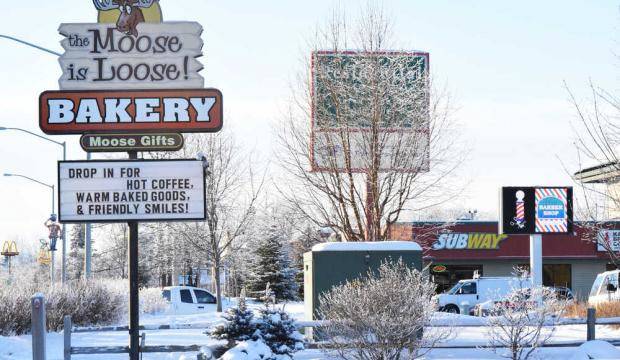The rules for signage in Soldotna are changing and although the exact details are still uncertain, preliminary plans allow for the use of sandwich board signs year round while limiting the use of temporary signs to seven days a year.
At the City Council meeting last Wednesday, City Planner John Czarnezki and Director of Economic Development and Planning Stephanie Queen detailed a portion of what the Planning and Zoning Commission has been working on since January.
“The regulations for the temporary signs go hand in hand with the proposal for sandwich boards,” Czarnezki said. “Currently, sandwich boards are completely prohibited, but if this goes forward, it would open up a new form of advertising.”
The sandwich boards, also known as a-frame signs, would be allowed to be displayed all year while, currently, they are completely prohibited. Temporary signs, such as banners and ‘sale’ signage, would be restricted to a maximum of five signs for seven calendar days a year. Currently, regulations allow temporary signs to be up for 60 days.
“It would offer a much greater opportunity that exists today to advertise,” Czarnezki said. “So we thought … because there is now this ability to advertise every day, we could reduce the amount of time that the temporary signs are allowed to be displayed.”
The proposal limits the sandwich board signs to one per parcel, to a size no bigger than 12 square feet and would ensure that the signs are not lit up in any way. All sandwich boards would have to be brought in between midnight and 5 a.m.
“Essentially, you would have to bring them in every night,” Czarneski said.
No permitting would be required for sandwich board signs.
The accessibility of advertising through sandwich boards would, effectively, limit the need for temporary signs by having a moveable and customizable, yet permanent, display sign available to retailers.
“We were thinking if they do need to advertise that they have a special sale or they need help or whatever the reason, they still have that opportunity to do a temporary sign,” Czarneski said.
According to Queen, many of the complaints previously received about temporary signs came from other businesses. This spring, though, the city laxed on enforcing sign rules and a wide array of complaints came in, but a clear cut solution has been hard to come by.
“The proposal we’re bringing is relaxing the current standards, but from that as a starting point, I think we’re able to go in any number of directions,” Queen said. “What we’ve experienced is there hasn’t been a lot of consensus on many of our proposals. It’s been a really tricky thing for us.”
The discussion on signage in Soldotna will continue at the Planning and Zoning Commission meetings. The next meeting will be Sept. 6 at 5:30 p.m. in Soldotna City Hall Council Chambers.
Reach Kat Sorensen at kat.sorensen@peninsulaclarion.com
